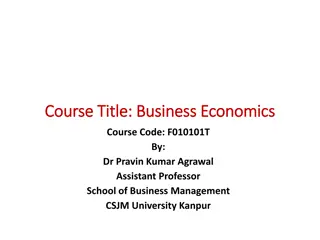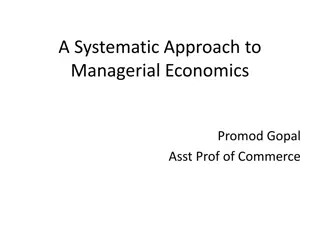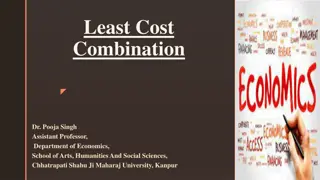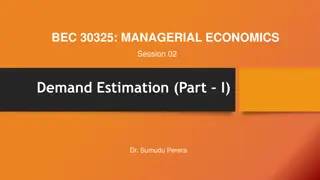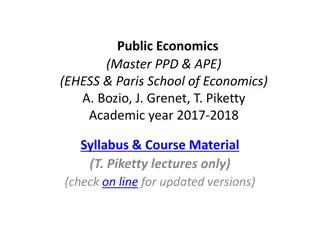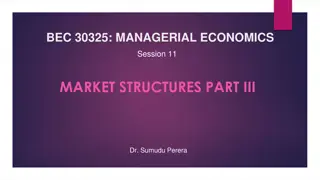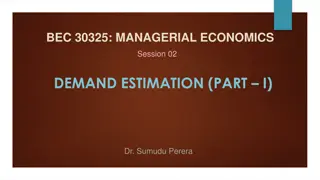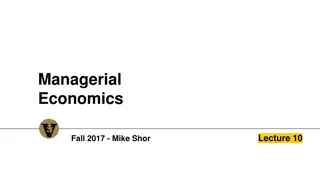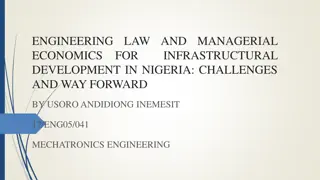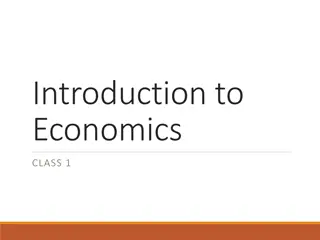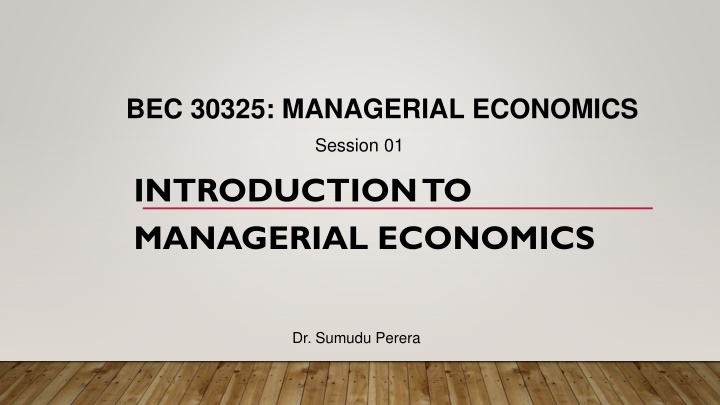
INTRODUCTION TO MANAGERIAL ECONOMICS
Managerial Economics integrates economic theory with decision science tools to optimize business decision-making processes. It examines profit maximization, resource utilization, pricing strategies, competition, and the impact of external factors on firms.
Download Presentation

Please find below an Image/Link to download the presentation.
The content on the website is provided AS IS for your information and personal use only. It may not be sold, licensed, or shared on other websites without obtaining consent from the author. If you encounter any issues during the download, it is possible that the publisher has removed the file from their server.
You are allowed to download the files provided on this website for personal or commercial use, subject to the condition that they are used lawfully. All files are the property of their respective owners.
The content on the website is provided AS IS for your information and personal use only. It may not be sold, licensed, or shared on other websites without obtaining consent from the author.
E N D
Presentation Transcript
BEC 30325: MANAGERIAL ECONOMICS Session 01 INTRODUCTION TO MANAGERIAL ECONOMICS Dr. Sumudu Perera
Session Outline Nature and scope of Managerial Economics Goals and Constraints of business organizations The Theory of the firm The nature and importance of profit Economic Profit and Accounting Profit Quantitative techniques in Managerial Economics
Managerial Economics Managerial Economics is the integration of economic theory with decision science tools, so as to make decision making effective and efficient. The application of economic theory and the tools of decision science to examine how an organization can achieve its aims or objectives most efficiently.
Managerial Economics deals with: How decisions should be made by managers to achieve the firm s goals-in particular, how to maximize profit
Managerial Decision Problems Economic theory Microeconomics Macroeconomics Decision Sciences Mathematical Economics Econometrics MANAGERIAL ECONOMICS Application of economic theory and decision science tools to solve managerial decision problems OPTIMAL SOLUTIONS TO MANAGERIAL DECISION PROBLEMS
ECONOMICS VS. MANAGERIAL ECONOMICS 6 ECONOMICS MANAGERIAL ECONOMICS Study of economic theory Application of economic theory Belongs to positive economics Belongs to normative economics Examine the human behavior on using scarce resources on unlimited needs and wants Study the way of applying economic theory for decision making in firms Limited Scope Wide scope
Why is Managerial Economics Important? To estimate economic relationships To make decisions related to internal issues Effectively utilize resources (What/how much/how/to whom, to produce) Pricing Face price and non-price competitions Maximizing sales, revenues, profits To identify the impact of external factors on the firm To use theoretical concepts in economics to actual behavior of firms A powerful analytical engine .
THEORY OF THE FIRM Combines and organizes resources for the purpose of producing goods and/or services for sale. Internalizes transactions, reducing transactions costs. Primary goal is to maximize the wealth or value of the firm.
EXAMPLE -THEORY OF THE FIRM Mr. Smith, an entrepreneur decides to set up a company by recruiting people to work for wages, by purchasing a property for the workplace machinery for the factory. He believes that it is very much efficient and less costly to run a business through a firm, rather than him doing everything alone. He believes that a general contract agreed with laborers to perform a number of tasks for specific wages and benefits is less costly than specific contacts for each task undertaken. He can also internalize many functions such as Finance, Marketing, IT, Research and Development etc without giving those tasks to external parties.
VALUE OF THE FIRM The present value of all expected future profits
ALTERNATIVE THEORIES Sales maximization Adequate rate of profit Management utility maximization Principle-agent problem Satisficing behavior
DEFINITIONS OF PROFIT Business / Accounting Profit: Total revenue minus the explicit or accounting costs of production. Economic Profit: Total revenue minus the explicit and implicit costs of production. Opportunity Cost: Implicit value of a resource in its best alternative use.
EXAMPLE ACCOUNTING VS ECONOMIC PROFIT Maya is in the final year of the University and she has lectures only during the evening. Therefore she has free time to engage in an internship programme. She got the opportunity to work at a bank which pays Rs. 12000 per month. If she is to undertake the internship she has to incur extra travelling and food cost of Rs. 3000 per month. However Maya decides to bake cakes at home and sell for private parties. She earns Rs. 25000 per month by making cakes. The costs that she has to incur are given below; Ingredients Rs.4000 Packaging Rs.500 Electricity Rs.250 Find out the accounting profit and economic profit of carrying out the cake business.
FUNCTION OF PROFIT Profit is a signal that guides the allocation of society s resources. High profits in an industry are a signal that buyers want more of what the industry produces. Low (or negative) profits in an industry are a signal that buyers want less of what the industry produces.
THE CHANGING ENVIRONMENT OF MANAGERIAL ECONOMICS Globalization of Economic Activity Goods and Services Capital Technology Skilled Labor Technological Change Telecommunications Advances The Internet and the World Wide Web
Decision Science Tools 16 Numerical analysis Statistical estimation Forecasting Game theory Optimization Simulation Department of Business Economics, FMSC, USJP
BASIC TRAINING: RULES OF DIFFERENTIATION Constant Function Rule: Y = f(X) =0 dY dX dY dX b aX = 1 b Power Function Rule: dU dX dV dX = Sum-and-Differences Rule dY dX dV dX dU dX = + U V Product Rule
18 ( ) V ( ) dU dV V U Quotient Rule dY dX dX dX = 2 dY dX dY dU dU dX = Chain Rule

